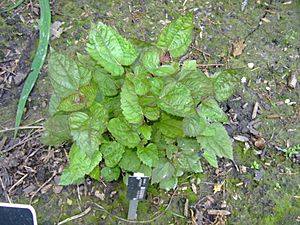Lucy Braun's snakeroot facts for kids
Quick facts for kids Lucy Braun's snakeroot |
|
|---|---|
 |
|
| Conservation status | |
| Scientific classification | |
| Synonyms | |
|
Ageratina luciae-brauniae is a type of flowering plant that belongs to the aster family. People often call it Lucy Braun's snakeroot or rockhouse white snakeroot. This plant grows naturally in the eastern United States. You can mostly find it in the Cumberland Plateau area of Kentucky and Tennessee. There might be some in South Carolina, but scientists haven't fully confirmed that yet.
Contents
What is Lucy Braun's Snakeroot?
This plant is a perennial herb, which means it lives for more than two years. It usually grows to be about 30 to 60 centimeters (about 1 to 2 feet) tall. Its leaves grow opposite each other on the stem. They are thin and shaped like an oval or a triangle, reaching up to 8 centimeters long and 9 centimeters wide. The plant's flowers grow in a group called an inflorescence. These are clusters of white flower heads. They have small disc florets but no ray florets, which are the petal-like parts you see on daisies.
Where Does This Plant Live?
Lucy Braun's snakeroot likes to grow in special places called rockhouses. These are sandy spots found under large overhangs of sandstone rock. The plant prefers moist areas where water drips down from the rocks above.
How Many Plants Are There?
There are about 40 to 50 known places where this plant grows. Some groups of these plants in Kentucky are quite large. However, many other groups have only a few plants. This means it's a somewhat rare plant.
The Story Behind the Name
The name Ageratina comes from the Greek word meaning 'un-aging'. This refers to how the plant's flowers keep their color for a long time. An ancient Greek doctor named Dioscorides used this name for different plants.
Naming After Dr. Emma Lucy Braun
This plant was first described in 1940 by an American botanist named Dr. Emma Lucy Braun. She initially named it Eupatorium deltoides. However, it turned out that this name had already been used three times before for other plants. So, a new name was needed.
Another botanist, Merritt Lyndon Fernald, then named it Eupatorium luciae-brauniae in honor of Dr. Braun. She was a famous botanist who lived from 1889 to 1971.


